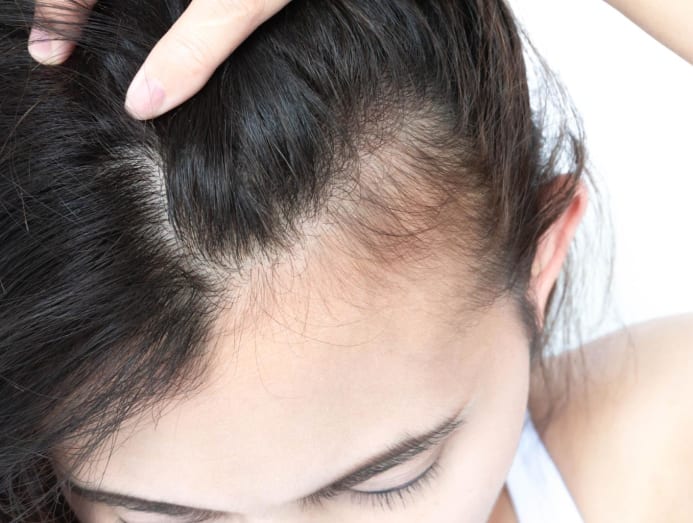Lupus strikes more women than men: What to know about the disease, signs, treatment and if you can get pregnant
Autoimmune diseases can be unnerving and scary. And one that can “attack” at any time and on any part of the body? Lupus is one of those conditions and is commonly found in women. CNA Women finds out more.

Lupus is an autoimmune disease that affects more women than men – nine in 10 occurrences are female, say experts – and it usually strikes during the reproductive ages of 15 to 45 years. (Photo: iStock/bymuratdeniz)
Lupus is a chronic autoimmune disease that can affect any part of the body. In fact, it has been described as “a disease of a thousand faces” because it presents itself in several ways and in one or many parts of the body.
An autoimmune disease is where the body is unable to tell the difference between viruses, bacteria or germs and its own healthy cells, tissues or organs. Thus, it can attack and destroy these healthy ones instead of the viruses.
A report by KK Women’s and Children’s Hospital (KKH) said that in Singapore, lupus affects 0.1 per cent of the population. Though it is uncommon, it affects more women than men.
Adjunct Associate Professor Faith Chia, senior consultant at Tan Tock Seng Hospital’s (TTSH) Department of Rheumatology, Allergy & Immunology, said that there is currently no cure for lupus but medication is prescribed to treat the symptoms from lupus flare-ups.
WHAT LUPUS LOOKS LIKE
Lupus symptoms can differ from person to person and affect any part of the body. The condition presents itself in a number of symptoms, including:
- Muscle and joint pain
- Fever
- Butterfly rash (or malar rash) over nose and cheeks
- Increased hair loss
- Chest pain
- Light sensitivity
- Kidney issues
- Extreme fatigue
- Anaemia
- Memory problems
- Blood clotting
- Eye issues
Assoc Prof Chia said patients may show abnormal kidney test results, have frothy urine from loss of protein or swelling in the legs. In severe cases, major organs including the lungs, heart and brain, and nerves, may be affected.
If you have any of the above symptoms and they persist, Assoc Prof Chia recommends seeing a doctor early for evaluation and treatment. “Because there is no single test that can diagnose lupus, it’s important to get a thorough assessment.”
WOMEN AND LUPUS – MORE LIKELY THAN MEN
Nine out of 10 occurrences of lupus are found in women, according to statistics from the Centers for Disease Control and Prevention in the United States. And while it can strike at any time to anyone, it occurs more often in women of child-bearing age from 15 to 45 years.
And it’s not only more women who are affected – their ethnicity plays a part. A US research study found that lupus is diagnosed in more African-American, Hispanic, Chinese, Indian and Malay women, as compared with Caucasian women.

While lupus affects women in their reproductive years, it doesn’t affect their chances of conceiving. However, the medications used to treat lupus can affect fertility. So it’s important to have a chat with your doctor about family planning.
Having lupus may also cause complications in pregnancy. “If a woman were to find herself pregnant, she should inform her rheumatologist immediately as pregnancy can cause the lupus to flare – close monitoring is essential till full-term.
“Normally, as rheumatologists, we will work closely with our patients’ gynaecologist-obstetricians to take care of both the mum and baby through the pregnancy,” said Assoc Prof Chia.
HOW I COPE WITH LUPUS: FOUR WOMEN SHARE THEIR STORIES
As lupus can be managed, many who have the disease find that they lead full lives being armed with knowledge about the condition, being in touch with their doctors and knowing their triggers.
Jennifer Oh, 40, teacher
Oh found out she had lupus in 1999 when she discovered a butterfly rash on her face after a run. She received a referral from the polyclinic to see a rheumatologist in Tan Tock Seng Hospital. She was given steroids to take as part of her treatment and put on 30kg because of it.
Knowing her triggers – stress such as from studying for major exams and sun exposure – and working closely with her doctor has helped. “I can detect a migraine coming (from stress) and will take a break when I sense it coming.”
She also eats healthy and stays active to keep the weight off and reduce stress.
Joy Tan, 36, staff nurse
Tan was diagnosed in 2009. She had a sudden onset of heart palpitations, chest pains and had low red blood count. Upon further tests, doctors found that her immune system was attacking those red blood cells.
“Lupus affected my kidneys in 2010 and I had severe body swelling, and needed a biopsy, Thankfully, my body responded well to the treatment. After 10 years, it can still be quite challenging as the symptoms can be quite subtle. But it has gotten easier to recognise the flares early before it gets serious.”
Yoke Yin Walker, 76, housewife
She was diagnosed with Systemic Lupus Erythematosus (SLE) in 1996 when she felt unexplained pain and was unable to walk far. After some blood tests with her general practitioner, she was referred to a rheumatologist.
“My lupus tends to affect my skin, joints and eyes. If it’s too hot or too cold, I suffer from rashes. If I cry too much, my eyes will give me issues and I have steroid drops to take care of them. I believe my lupus was brought on by stress as I had just moved with my family to Australia and was finding it hard to cope.
“Apart from the doctor’s medication, I found meditation helps me to stay focused and the practice gives me peace to live with the condition. I enjoy doing qigong and gardening, or just taking time to do my favourite things when I’m unhappy and keep the stress levels at bay.”
Marisa Chan, 40s, works in publishing
Chan had a double whammy when it came to lupus. “My first child was born with a strange rash on her skin. At her first month check-up, the paediatrician was concerned and ordered blood tests. His suspicions were right as she had neonatal lupus.
“He then recommended that I test for lupus myself as newborns inherit lupus through antibodies passed from the mother. The test confirmed I had SLE, although I had no symptoms then.
“Then, during my last pregnancy six years ago, I felt such extreme pain in body that I had to go to the A&E for a pain relief shot. The rheumatologist confirmed that my lupus was now active, and in a big way, and I was put on medication.
“Any flare-ups since then have been minor and the disease is under control. My daughter is now in her teens and healthy. Some parts of her skin are pitted where the lupus antibodies attacked her fat cells as a baby but it’s not severe.
“I’m careful to manage my stress levels and any UV exposure – I avoid gel manicures due to the UV lights used to cure the colour. I protect my health by wears a mask in crowded places like supermarkets and when my children are sick.”
DIFFERENT TYPES OF LUPUS
There are a few types of lupus and each has a separate set of causes and symptoms.
1. Systemic Lupus Erythematosus (SLE)
It is the most common and yet most serious type of lupus. It can affect many parts of the body and common symptoms include fatigue, hair loss, sun sensitivity, swollen and painful joints, fever, rashes and even kidney issues.
There are a number of tests to diagnose SLE and doctors will check on family history, personal health and request for blood and other laboratory tests.
2. Cutaneous Lupus Erythematosus (CLE)
CLE is a skin disease that can affect those with or without an existing SLE diagnosis. Symptoms for CLE come in the form of rashes, sun sensitivity, hair loss and even swelling of blood vessels.

To test whether one has CLE, doctors will remove a small piece of the skin where the rashes are to do tests.
With CLE, there are sub-groups, including discoid lupus erythematosus (DLE) where the red rash starts turning scaly or turns dark brown. This rash often appears on the face and scalp but may affect other areas.
DLE tends to leave scarring on the body and can even cause sores within the mouth or nose.
Having DLE may lead to having a subacute cutaneous lupus erythematosus (SCLE) diagnosis. This type of lupus causes skin lesions on the body when exposed to the sun.
3. Drug-induced Lupus
This is when certain drugs cause symptoms which are like those of SLE. They can cause joint and muscle pains, and fever. These SLE-like symptoms are not serious and rarely affect the major organs. Once the course of medication is stopped or completed, the symptoms go away.
4. Neonatal Lupus
This is a rare condition in babies who inherit lupus from certain antibodies the mother has. These mothers are often diagnosed with lupus already but if one has lupus, it doesn’t mean that the baby will be diagnosed with it.
Conversely, an infant can have neonatal lupus even if the mother isn’t suffering from the condition. However, there is a chance that the mother may develop the condition later in life.

Symptoms of neonatal lupus may present as a skin rash, liver issues or low blood cell counts. These tend to go away without any serious or lasting side effects. However, some infants may suffer from heart defects.
CAUSES OF LUPUS
There are no direct causes of lupus. Said Assoc Prof Chia: “The cases of SLE are very complex and are likely due to an interplay between genetics and environmental influence, leading to an auto-antibody formation and other immune changes that cause damage to various organs.”
Genetics may or may not play a part either. In general, while people who have family with lupus are at risk of getting lupus, the pattern of inheritance is not as straightforward as in other diseases. Assoc Prof Chia said environment triggers like intense sun exposure, infections, physical or emotional stress can play a role.
NO WAY OUT BUT TO TREAT THE SYMPTOMS
Depending on the severity of the lupus flares, most doctors prescribe different medications that aim to bring lupus under control. Rheumatologists would give medication such as hydroxychloroquine, steroids and immunosuppressants.
But such medication isn’t forever: Once the lupus is under control, or lupus is in remission, doses are reduced.
“We aim to reduce the medication to as little as possible needed to keep lupus in remission. It’s important that patients take their prescribed medication to prevent damage to their organs and flares of this disease,” said Assoc Prof Chia.
Patients with lupus are advised to stay out of the sun as prolonged UV light exposure may trigger flare-ups. Doctors will also advise a healthy diet and lifestyle, and strategies to manage their stress.
CNA Women is a section on CNA Lifestyle that seeks to inform, empower and inspire the modern woman. If you have women-related news, issues and ideas to share with us, email CNAWomen [at] mediacorp.com.sg.





